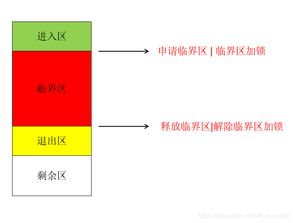如何解决进程同步问题,进程同步机制应遵循的原则
各位老铁们好,相信很多人对如何解决进程同步问题都不是特别的了解,因此呢,今天就来为大家分享下关于如何解决进程同步问题以及进程同步机制应遵循的原则的问题知识,还望可以帮助大家,解决大家的一些困惑,下面一起来看看吧!

linux 多进程信号同步问题
朋友你好:希望能帮到你。互相学习。
线程的最大特点是资源的共享性,但资源共享中的同步问题是多线程编程的难点。linux下提供了多种方式来处理线程同步,最常用的是互斥锁、条件变量和信号量。
1)互斥锁(mutex)
通过锁机制实现线程间的同步。同一时刻只允许一个线程执行一个关键部分的代码。
int pthread_mutex_init(pthread_mutex_t*mutex,const pthread_mutex_attr_t*mutexattr);
int pthread_mutex_lock(pthread_mutex*mutex);
int pthread_mutex_destroy(pthread_mutex*mutex);
int pthread_mutex_unlock(pthread_mutex*
(1)先初始化锁init()或静态赋值pthread_mutex_t mutex=PTHREAD_MUTEX_INITIALIER
attr_t有:
PTHREAD_MUTEX_TIMED_NP:其余线程等待队列
PTHREAD_MUTEX_RECURSIVE_NP:嵌套锁,允许线程多次加锁,不同线程,解锁后重新竞争
PTHREAD_MUTEX_ERRORCHECK_NP:检错,与一同,线程请求已用锁,返回EDEADLK;
PTHREAD_MUTEX_ADAPTIVE_NP:适应锁,解锁后重新竞争
(2)加锁,lock,trylock,lock阻塞等待锁,trylock立即返回EBUSY
(3)解锁,unlock需满足是加锁状态,且由加锁线程解锁
(4)清除锁,destroy(此时锁必需unlock,否则返回EBUSY,//Linux下互斥锁不占用内存资源
示例代码
#include<cstdio>
#include<cstdlib>
#include<unistd.h>
#include<pthread.h>
#include"iostream"
using namespace std;
pthread_mutex_t mutex= PTHREAD_MUTEX_INITIALIZER;
int tmp;
void* thread(void*arg)
{
cout<<"thread id is"<< pthread_self()<< endl;
pthread_mutex_lock(&mutex);
tmp= 12;
cout<<"Now a is"<< tmp<< endl;
pthread_mutex_unlock(&mutex);
return NULL;
}
int main()
{
pthread_t id;
cout<<"main thread id is"<< pthread_self()<< endl;
tmp= 3;
cout<<"In main func tmp="<< tmp<< endl;
if(!pthread_create(&id, NULL, thread, NULL))
{
cout<<"Create thread success!"<< endl;
}
else
{
cout<<"Create thread failed!"<< endl;
}
pthread_join(id, NULL);
pthread_mutex_destroy(&mutex);
return 0;
}
编译: g++-o thread testthread.cpp-lpthread
说明:pthread库不是Linux系统默认的库,连接时需要使用静态库libpthread.a,所以在使用pthread_create()创建线程,以及调用pthread_atfork()函数建立fork处理程序时,需要链接该库。在编译中要加-lpthread参数。
2)条件变量(cond)
利用线程间共享的全局变量进行同步的一种机制。条件变量上的基本操作有:触发条件(当条件变为 true时);等待条件,挂起线程直到其他线程触发条件。
int pthread_cond_init(pthread_cond_t*cond,pthread_condattr_t*cond_attr);
int pthread_cond_wait(pthread_cond_t*cond,pthread_mutex_t*mutex);
int pthread_cond_timewait(pthread_cond_t*cond,pthread_mutex*mutex,const timespec*abstime);
int pthread_cond_destroy(pthread_cond_t*cond);
int pthread_cond_signal(pthread_cond_t*cond);
int pthread_cond_broadcast(pthread_cond_t*cond);//解除所有线程的阻塞
(1)初始化.init()或者pthread_cond_t cond=PTHREAD_COND_INITIALIER(前者为动态初始化,后者为静态初始化);属性置为NULL
(2)等待条件成立.pthread_wait,pthread_timewait.wait()释放锁,并阻塞等待条件变量为真,timewait()设置等待时间,仍未signal,返回ETIMEOUT(加锁保证只有一个线程wait)
(3)激活条件变量:pthread_cond_signal,pthread_cond_broadcast(激活所有等待线程)
(4)清除条件变量:destroy;无线程等待,否则返回EBUSY
对于
int pthread_cond_wait(pthread_cond_t*cond, pthread_mutex_t*mutex);
int pthread_cond_timedwait(pthread_cond_t*cond, pthread_mutex_t*mutex, const struct timespec*abstime);
一定要在mutex的锁定区域内使用。
如果要正确的使用pthread_mutex_lock与pthread_mutex_unlock,请参考
pthread_cleanup_push和pthread_cleanup_pop宏,它能够在线程被cancel的时候正确的释放mutex!
另外,posix1标准说,pthread_cond_signal与pthread_cond_broadcast无需考虑调用线程是否是mutex的拥有者,也就是说,可以在lock与unlock以外的区域调用。如果我们对调用行为不关心,那么请在lock区域之外调用吧。
说明:
(1)pthread_cond_wait自动解锁互斥量(如同执行了pthread_unlock_mutex),并等待条件变量触发。这时线程挂起,不占用CPU时间,直到条件变量被触发(变量为ture)。在调用 pthread_cond_wait之前,应用程序必须加锁互斥量。pthread_cond_wait函数返回前,自动重新对互斥量加锁(如同执行了pthread_lock_mutex)。
(2)互斥量的解锁和在条件变量上挂起都是自动进行的。因此,在条件变量被触发前,如果所有的线程都要对互斥量加锁,这种机制可保证在线程加锁互斥量和进入等待条件变量期间,条件变量不被触发。条件变量要和互斥量相联结,以避免出现条件竞争——个线程预备等待一个条件变量,当它在真正进入等待之前,另一个线程恰好触发了该条件(条件满足信号有可能在测试条件和调用pthread_cond_wait函数(block)之间被发出,从而造成无限制的等待)。
(3)pthread_cond_timedwait和 pthread_cond_wait一样,自动解锁互斥量及等待条件变量,但它还限定了等待时间。如果在abstime指定的时间内cond未触发,互斥量mutex被重新加锁,且pthread_cond_timedwait返回错误 ETIMEDOUT。abstime参数指定一个绝对时间,时间原点与 time和 gettimeofday相同:abstime= 0表示 1970年1月1日00:00:00 GMT。
(4)pthread_cond_destroy销毁一个条件变量,释放它拥有的资源。进入 pthread_cond_destroy之前,必须没有在该条件变量上等待的线程。
(5)条件变量函数不是异步信号安全的,不应当在信号处理程序中进行调用。特别要注意,如果在信号处理程序中调用 pthread_cond_signal或pthread_cond_boardcast函数,可能导致调用线程死锁。
示例程序1
#include<stdio.h>
#include<pthread.h>
#include"stdlib.h"
#include"unistd.h"
pthread_mutex_t mutex;
pthread_cond_t cond;
void hander(void*arg)
{
free(arg);
(void)pthread_mutex_unlock(&mutex);
}
void*thread1(void*arg)
{
pthread_cleanup_push(hander,&mutex);
while(1)
{
printf("thread1 is running\n");
pthread_mutex_lock(&mutex);
pthread_cond_wait(&cond,&mutex);
printf("thread1 applied the condition\n");
pthread_mutex_unlock(&mutex);
sleep(4);
}
pthread_cleanup_pop(0);
}
void*thread2(void*arg)
{
while(1)
{
printf("thread2 is running\n");
pthread_mutex_lock(&mutex);
pthread_cond_wait(&cond,&mutex);
printf("thread2 applied the condition\n");
pthread_mutex_unlock(&mutex);
sleep(1);
}
}
int main()
{
pthread_t thid1,thid2;
printf("condition variable study!\n");
pthread_mutex_init(&mutex,NULL);
pthread_cond_init(&cond,NULL);
pthread_create(&thid1,NULL,thread1,NULL);
pthread_create(&thid2,NULL,thread2,NULL);
sleep(1);
do
{
pthread_cond_signal(&cond);
}while(1);
sleep(20);
pthread_exit(0);
return 0;
}
示例程序2:
#include<pthread.h>
#include<unistd.h>
#include"stdio.h"
#include"stdlib.h"
static pthread_mutex_t mtx= PTHREAD_MUTEX_INITIALIZER;
static pthread_cond_t cond= PTHREAD_COND_INITIALIZER;
struct node
{
int n_number;
struct node*n_next;
}*head= NULL;
/*[thread_func]*/
static void cleanup_handler(void*arg)
{
printf("Cleanup handler of second thread./n");
free(arg);
(void)pthread_mutex_unlock(&mtx);
}
static void*thread_func(void*arg)
{
struct node*p= NULL;
pthread_cleanup_push(cleanup_handler, p);
while(1)
{
//这个mutex主要是用来保证pthread_cond_wait的并发性
pthread_mutex_lock(&mtx);
while(head== NULL)
{
//这个while要特别说明一下,单个pthread_cond_wait功能很完善,为何
//这里要有一个while(head== NULL)呢?因为pthread_cond_wait里的线
//程可能会被意外唤醒,如果这个时候head!= NULL,则不是我们想要的情况。
//这个时候,应该让线程继续进入pthread_cond_wait
// pthread_cond_wait会先解除之前的pthread_mutex_lock锁定的mtx,
//然后阻塞在等待对列里休眠,直到再次被唤醒(大多数情况下是等待的条件成立
//而被唤醒,唤醒后,该进程会先锁定先pthread_mutex_lock(&mtx);,再读取资源
//用这个流程是比较清楚的/*block-->unlock-->wait() return-->lock*/
pthread_cond_wait(&cond,&mtx);
p= head;
head= head->n_next;
printf("Got%d from front of queue/n", p->n_number);
free(p);
}
pthread_mutex_unlock(&mtx);//临界区数据操作完毕,释放互斥锁
}
pthread_cleanup_pop(0);
return 0;
}
int main(void)
{
pthread_t tid;
int i;
struct node*p;
//子线程会一直等待资源,类似生产者和消费者,但是这里的消费者可以是多个消费者,而
//不仅仅支持普通的单个消费者,这个模型虽然简单,但是很强大
pthread_create(&tid, NULL, thread_func, NULL);
sleep(1);
for(i= 0; i< 10; i++)
{
p=(struct node*)malloc(sizeof(struct node));
p->n_number= i;
pthread_mutex_lock(&mtx);//需要操作head这个临界资源,先加锁,
p->n_next= head;
head= p;
pthread_cond_signal(&cond);
pthread_mutex_unlock(&mtx);//解锁
sleep(1);
}
printf("thread 1 wanna end the line.So cancel thread 2./n");
//关于pthread_cancel,有一点额外的说明,它是从外部终止子线程,子线程会在最近的取消点,退出
//线程,而在我们的代码里,最近的取消点肯定就是pthread_cond_wait()了。
pthread_cancel(tid);
pthread_join(tid, NULL);
printf("All done-- exiting/n");
return 0;
}
3)信号量
如同进程一样,线程也可以通过信号量来实现通信,虽然是轻量级的。
信号量函数的名字都以"sem_"打头。线程使用的基本信号量函数有四个。
#include<semaphore.h>
int sem_init(sem_t*sem, int pshared, unsigned int value);
这是对由sem指定的信号量进行初始化,设置好它的共享选项(linux只支持为0,即表示它是当前进程的局部信号量),然后给它一个初始值VALUE。
两个原子操作函数:
int sem_wait(sem_t*sem);
int sem_post(sem_t*sem);
这两个函数都要用一个由sem_init调用初始化的信号量对象的指针做参数。
sem_post:给信号量的值加1;
sem_wait:给信号量减1;对一个值为0的信号量调用sem_wait,这个函数将会等待直到有其它线程使它不再是0为止。
int sem_destroy(sem_t*sem);
这个函数的作用是再我们用完信号量后都它进行清理。归还自己占有的一切资源。
示例代码:
#include<stdlib.h>
#include<stdio.h>
#include<unistd.h>
#include<pthread.h>
#include<semaphore.h>
#include<errno.h>
#define return_if_fail(p) if((p)== 0){printf("[%s]:func error!/n", __func__);return;}
typedef struct _PrivInfo
{
sem_t s1;
sem_t s2;
time_t end_time;
}PrivInfo;
static void info_init(PrivInfo* thiz);
static void info_destroy(PrivInfo* thiz);
static void* pthread_func_1(PrivInfo* thiz);
static void* pthread_func_2(PrivInfo* thiz);
int main(int argc, char** argv)
{
pthread_t pt_1= 0;
pthread_t pt_2= 0;
int ret= 0;
PrivInfo* thiz= NULL;
thiz=(PrivInfo*)malloc(sizeof(PrivInfo));
if(thiz== NULL)
{
printf("[%s]: Failed to malloc priv./n");
return-1;
}
info_init(thiz);
ret= pthread_create(&pt_1, NULL,(void*)pthread_func_1, thiz);
if(ret!= 0)
{
perror("pthread_1_create:");
}
ret= pthread_create(&pt_2, NULL,(void*)pthread_func_2, thiz);
if(ret!= 0)
{
perror("pthread_2_create:");
}
pthread_join(pt_1, NULL);
pthread_join(pt_2, NULL);
info_destroy(thiz);
return 0;
}
static void info_init(PrivInfo* thiz)
{
return_if_fail(thiz!= NULL);
thiz->end_time= time(NULL)+ 10;
sem_init(&thiz->s1, 0, 1);
sem_init(&thiz->s2, 0, 0);
return;
}
static void info_destroy(PrivInfo* thiz)
{
return_if_fail(thiz!= NULL);
sem_destroy(&thiz->s1);
sem_destroy(&thiz->s2);
free(thiz);
thiz= NULL;
return;
}
static void* pthread_func_1(PrivInfo* thiz)
{
return_if_fail(thiz!= NULL);
while(time(NULL)< thiz->end_time)
{
sem_wait(&thiz->s2);
printf("pthread1: pthread1 get the lock./n");
sem_post(&thiz->s1);
printf("pthread1: pthread1 unlock/n");
sleep(1);
}
return;
}
static void* pthread_func_2(PrivInfo* thiz)
{
return_if_fail(thiz!= NULL);
while(time(NULL)< thiz->end_time)
{
sem_wait(&thiz->s1);
printf("pthread2: pthread2 get the unlock./n");
sem_post(&thiz->s2);
printf("pthread2: pthread2 unlock./n");
sleep(1);
}
return;
}
通过执行结果后,可以看出,会先执行线程二的函数,然后再执行线程一的函数。它们两就实现了同步
进程之间的同步方式有哪些
同步和通讯的目的是一样的,实现进程间数据共享,同步只是为了做到处理协同。共享内存在Win9X平台上是有的,在NT内核以后就没有这一说了,因为进程地址空间不再有共用部分 Linux:通信就是说进程之间传递数据。常见的方法有 pipe(管道),FIFO(命名管道),socket(套接字),SysVIPC的 shm(共享内存)、msg queue(消息队列),mmap(文件映射)。以前还有 STREAM,不过现在比较少见了(好像)。同步的意思是说,让不同进程能够在同时到达一个已知的特定状态之前等待另一方的执行。Linux下常见的同步方法有SysVIPC的 sem(信号量)、file locking/ record locking(通过 fcntl设定的文件锁、记录锁)、futex(基于共享内存的快速用户态互斥锁)。针对线程(pthread)的还有 pthread_mutex和 pthread_cond(条件变量)。除了这些特定的同步对象之外,还有一些同步方法是与通信方法不可分离的,包括:对 pipe/FIFO/socket和 msg queue的阻塞等待、对子进程退出事件的等待(wait族)、对线程退出时间的等待(pthread_join)另外还有一个不能不提的,就是信号。
进程同步机制应遵循的原则
进程同步机制应遵循的原则如下:
1、互斥原则:在任何时刻,只有一个进程可以执行。这意味着任何两个进程不能同时占用临界资源,必须互相等待对方释放资源。
2、同步原则:进程之间应按照一定的顺序执行,这个顺序是由它们的依赖关系确定的。一些进程需要等待其他进程到达某个状态后才能继续执行,这被称为同步。
3、通信原则:进程之间需要建立通信机制,以便彼此了解对方的状态和需求。例如,一个进程可以发送信号给另一个进程,通知它可以进行某项操作。
4、调度原则:操作系统应该根据某种策略来调度进程的执行顺序。常见的调度策略有先来先服务、短作业优先、优先级调度等。死锁预防原则:死锁是进程同步中常见的问题,应该采取措施预防死锁的发生。
5、错误处理原则:当出现错误时,操作系统应该能够检测并处理错误,以保证进程同步的正确性和可靠性。例如,避免循环等待资源、预先分配资源、检测并解除死锁等。
进程同步机制的应用如下:
1、程同步机制广泛应用于许多实际场景中,以确保并发进程能够按照预定的顺序和规则执行。例如,在生产者消费者问题中,生产者和消费者两个进程需要共享同一个缓冲区进行数据的交换。为了保证数据的正确性和一致性,需要使用进程同步机制来协调它们的执行顺序。
2、另外,在分布式系统中,多个节点需要互相协作完成任务,进程同步机制也是不可或缺的。通过使用锁、信号量、消息传递等同步机制,可以确保分布式系统中的各个节点能够按照统一的节奏和步调执行任务,从而实现整个系统的协同工作。
3、同时,进程同步机制也被广泛应用于数据库管理系统、网络通信系统、实时控制系统等领域。在这些系统中,进程同步机制的作用是确保并发操作的正确性和可靠性,防止出现数据不一致、丢失或冲突等问题。

